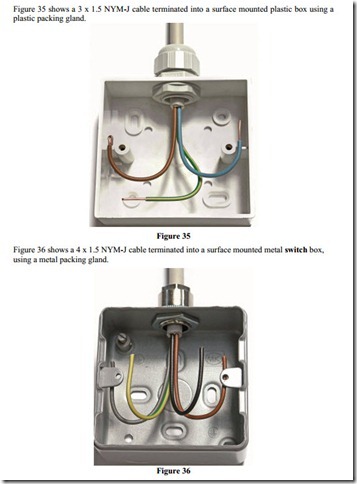NYM-J Cables
These cables are extremely popular as they offer good mechanical protection and are quite pleasing to the eye. They are very easily installed and can be painted to blend in with the surroundings. The construction of NYM cable is identified by the following code letters:
|
· |
N |
German Standard ( means it meets the German VDE specification ) |
|
· |
Y |
PVC ( Insulation ) |
|
· |
M |
Mantle ( German for sheath ) |
|
· |
J |
CPC ( includes earth wire with green and yellow insulation ) |
Construction of NYM-J Cable
The conductors, of soft-drawn copper, ( solid up to 10mm2 ) are PVC insulated. They are surrounded by a filling compound to produce a circular shape. The sheath of the cable is of Protruder ( polyvinyl chloride based compound ), which is mechanically tough and resistant to most chemical action. It is also flame retardant and self extinguishing. The colour of the NYM- J sheath is grey. It is manufactured in the usual range of conductor sizes up to 35 mm2.
The cable contains a protective conductor which is colour-coded green / yellow and whose cross-sectional area is equal to that of the current carrying conductors.
A particular feature of NYM-J cable is its tough outer sheath, which affords good mechanical protection. The overall cable is pliable which is of significant advantage in installation. The fully insulated “protective conductor” contained in the cable has the same conductance as the current carrying conductors and ensures a direct and secure protective path.
NYM-J cable conforms to specification for double insulation and when used with plastic glands and accessories, it offers the advantage of a double insulated installation.
Application of NYM-J Cable
NYM-J cable is suitable for permanent wiring on the surface. It is particularly suitable in damp and wet locations. It may be used outside but is not suitable for burial directly in the ground. It is primarily intended for use in industrial, commercial and agricultural premises. It is suitable for use in any temperature between -40°C and +60°C.
NYM-J cables have a wide range of applications, some of which are listed below.
· Lighting and power installations in shops
· Lighting and power installations on farms
· Sub-main distribution
· Underground supplies ( must be installed in suitable pipe )
Installation of NYM-J Cables
NYM-J cable can be fixed directly onto walls using cable clips. If several cables are to follow the same route they may best be supported on a cable tray or rack system. The minimum internal bend radius is found by multiplying the overall diameter of the cable by a factor of 4. Most standard fixing accessories are suitable. It should not be worked below 5°C.
Termination of NYM-J Cable
To a small degree this depends on which type of gland is being used. The clamping / sealing arrangement varies from one type of gland to another. Sometimes a waterproof termination is required. Standard plastic or metal Packing Glands ensure speedy and reliable terminations.
For example PG 11, PG 13 etc.
Listed below are the steps to be followed when terminating an NYM-J cable:
· Fix gland in position in enclosure and tighten.
· Adjust rubber seal to suit cable diameter ( Remove rubber rings as required )
· Fit gland nut, washer and rubber seal over cable
· Decide the point to which the cable sheath must be removed
( must protrude beyond the gland into the enclosure to protect the insulation )
· Cut around the circumference of the cable and pull off the outer sheath ( a longitudinal cut of the sheath is not necessary ).
· Remove filling compound.
· Enter cable into gland and work rubber seal into position
· Work washer and gland nut into position and tighten gland nut
( cable sheath should appear 5 – 10 mm inside enclosure )
· Bare the required length of the conductor with the help of suitable stripping pliers.
· Terminate conductors as normal.

